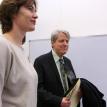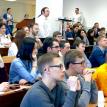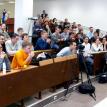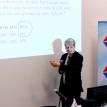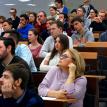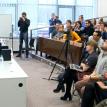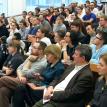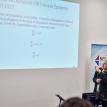“NES is a famous school in the States. I am happy to come to NES,” said Professor Shiller at the beginning of his presentation. He spoke with students about his 2016 article, “Popular Attitudes towards Markets and Democracy: Russia and United States compared 25 years later.” Professor Shiller conducted this research with Maxim Boyko, a Russian economist and Board member of NES. The scientists compared replies to questions about attitudes towards free markets and democracy in 1990 and 2015 and found out that after 25 years' experience in the market economy, the attitude of Russians to the markets hasn't changed and remains approximately the same as that of Americans.
Professor Shiller then went on to discuss his research in the field of Narrative Economics: “There is too much reliance on rational optimizing models, and I think that people are very silly because of stories they heard somewhere, because of narratives. I think economists gave people too much credit,” he said. In his view, human brains have always been highly tuned towards narratives, whether factual or not, that justify ongoing actions, even such basic actions as spending and investing.
He examined the spread of economic narratives through the lens of epidemiologists who build mathematical models of the spread of diseases. For instance, the Kermack Mc-Kendrick mathematical theory of disease epidemics marked a revolution in medical thinking because it offered a realistic framework for understanding the all-important dynamics of infectious diseases. “I think this may be the beginning of a transition to epidemic models of economics,” he said.
One example of a narrative epidemic can be seen in the history of the Laffer Curve, a model, created by economist Arthur Laffer, which purports to reflect the relationship between tax revenues and tax rates. The Laffer Curve observes that at a zero-percent tax rate, the government collects no revenue. However, at a 100% tax rate, the government would also collect no revenue, because people would not work if all of their income is taken. All situations between these two end-points are described by this U-shaped curve. From this observation, it follows that the same amount of tax revenue can be gathered at higher and lower rates. The story of the Laffer Curve was not well-known in 1974, when Laffer first introduced it. Its contagion is explained by an article that was first published in 1978 by Wall Street Journal journalist Jude Wanniski. He wrote a colorful story about Laffer sharing a dinner with top White House officials Dick Cheney and Donald Rumsfeld, as well as Wanniski. Laffer drew his curve on a napkin at the restaurant table. When news about the “curve drawn on a napkin” came out, with Wanniski’s help, this story went viral. Laffer himself said that he could not even remember the event. Interest in the Laffer Curve was widespread during the Reagan presidency during which the top U.S. income bracket was reduced from 78% to 28%.
A different, special kind of epidemic model can describe speculative bubbles, like Bitcoin. “This is an epidemic and it’s powered by a narrative. I asked an expert, Princeton University professor of Computer Science, what Bitcoin is, and I understood that you can’t understand Bitcoin in an hour and a half. The only thing I know about Bitcoin – when I talk with people about it – they wake up. They love Bitcoin. But Bitcoin is a bubble,” he said.
The viral spread of information can also be seen in financial crashes. The story of the crisis of 1929 is of interest even now, many years later. Rumors and speculation about the possibility of a crash began two years before the actual crash. Before the crisis, there were two different spikes in newspaper discussion, and each reached its peak within a year, indicating a very strong short-run contagion. The crisis of 1987 (“Black Monday”) actually looks far stronger than that of 1929, but interest in it is derived from the memory of the crisis of 1929.
Robert Shiller is also sure that Economics should change because of big data. And the advent of big data and of better algorithms for semantic searches might bring more credibility to the study of Narrative Economics.



